As an outdoor enthusiast and kayaking aficionado, I love the sense of freedom and adventure I experience while navigating through beautiful waterways. Kayaking has a special way of connecting us with nature, providing an unmatched sense of tranquility as we glide across the water’s surface. However, as peaceful and serene as kayaking can be, this popular pastime is not without its challenges and concerns. One question I occasionally come across, both in my circle of kayaker friends and among aspiring paddlers, is: can you get stuck upside down in a kayak?
While kayaking mishaps such as getting stuck or finding it difficult to exit a kayak are relatively rare, they can happen, especially if you’re new to the activity. But fear not! With the right preparation, knowledge, and some essential skills, you can reduce your risk of experiencing this uncomfortable situation. In this article, I’ll be discussing kayak design and its impact on the likelihood of getting stuck, tips for choosing the right kayak, and essential techniques to avoid any such predicaments.
Additionally, I’ll be sharing safety precautions, advice on dressing appropriately for kayaking, and how to maintain a positive mindset throughout your paddling adventures. Let’s dive in and explore what you need to know to fully enjoy your time out on the water – without getting stuck!
Contents
Contents
How Kayak Design Can Impact The Possibility Of Getting Stuck?

As a kayaking enthusiast, I’ve come to understand the significant role that kayak design plays in the possibility of getting stuck. Several factors in a kayak’s design contribute to this, and being aware of them can help you avoid uncomfortable and potentially dangerous situations. Here, we’ll delve into the various aspects of kayak design that you should consider to minimize the risk of getting stuck.
Width, Depth, And Cockpit Size
A key aspect of any kayak’s design is its width and depth. Wider and deeper kayaks often provide greater stability and can accommodate larger paddlers, whereas narrower and shallower boats can be faster and more maneuverable. When it comes to the risk of getting stuck, a well-proportioned kayak that provides a comfortable fit for your body size is crucial.
The size of the cockpit is another important design factor to consider. A smaller cockpit can make it more difficult to enter or exit the kayak, particularly for less experienced paddlers. On the other hand, a larger cockpit allows for easier ingress and egress but may sacrifice some control.
Sit-On-Top Vs. Sit-Inside Kayaks
Kayaks generally come in two main styles: sit-on-top (SOT) and sit-inside. Sit-on-top kayaks are generally considered more beginner-friendly, as they are more stable and very unlikely to trap you in the event of a capsize. Their open design allows you to easily slide off the kayak if needed.
Sit-inside kayaks, on the other hand, have a more enclosed design, with the paddler sitting inside the cockpit. These kayaks can offer better control and performance but also present a higher risk of getting stuck for inexperienced paddlers. A well-fitted spray skirt, which attaches to the cockpit to prevent water from entering, can increase the difficulty of exiting a sit-inside kayak – but it’s important to use one, as it will keep water from entering the cockpit in the first place!
The Importance Of Choosing A Kayak That Fits Your Body Size
Ultimately, choosing the right kayak for your body size is key to preventing the risk of getting stuck. When looking for a kayak, consider factors such as your height, weight, and leg length. Many kayak manufacturers provide sizing guidelines to help you choose the appropriate boat for your individual needs.
Kayak design plays a significant role in the possibility of getting stuck. Understanding these factors and selecting a well-fitted kayak that meets your needs and preferences will reduce the risk of this occurring and will ensure a safer, more enjoyable time on the water.
How To Choose The Right Kayak For You?

Selecting the appropriate kayak can be a daunting task, especially with the variety of options available in the market. However, making the right choice is essential for your safety, comfort, and overall kayaking experience. In this section, I will provide you with some essential tips to assist you in finding the perfect kayak.
1. Determine the Kayak’s Purpose
Before delving into the specifics, it is crucial to identify the primary purpose of your kayak. Will you be using it for leisurely paddling on calm lakes, navigating through fast-moving rapids, or perhaps embarking on extended touring adventures? By determining what you want to do with your kayak, you can narrow down your options significantly.
2. Sit-On-Top vs. Sit-Inside Kayaks
As mentioned earlier, one fundamental distinction between kayaks is whether they are sit-on-top or sit-inside models. Sit-on-top kayaks are generally more beginner-friendly, offering an open, easy-to-enter design, and better stability. In contrast, sit-inside kayaks provide a lower center of gravity, better control, and more efficient paddling, which may be preferable for more experienced kayakers. Reflect on your skill level and preferences, and choose a design that suits you best.
3. Key Factors To Consider
When browsing kayak options, keep these key factors in mind:
- Size and weight: Your kayak should be able to support your weight, along with any gear you plan on carrying. Additionally, ensure that the kayak’s length aligns with its intended use, as longer kayaks provide greater speed and straight-line tracking, while shorter ones are more maneuverable.
- Cockpit dimensions: You’ll want a cockpit that can comfortably accommodate your body size, thus ensuring a snug yet comfortable fit. This plays a significant role in preventing you from getting stuck in your kayak and allows you to maintain better control and stability in the water.
- Material and construction: Kayaks are made from various materials, each impacting the kayak’s weight, durability, and price. Common materials include rotomolded polyethylene (affordable and durable), fiberglass (lightweight and higher performance), and thermoformed plastic (lightweight and durable).
- Price and quality: Set a budget for your kayak purchase, but remember that a more expensive kayak may offer better performance and durability. In the long run, investing in a quality product could save you money on repairs and replacements.
4. Try Before You Buy
If possible, rent or try out different kayaks to get a feel for their distinct characteristics before making a purchase. Test paddling a kayak will give you invaluable firsthand experience, enabling you to make a well-informed decision. Reach out to local kayaking shops, rental services, or even fellow paddlers for an opportunity to try different models and designs.
5. Seat And Footrest Adjustability
A good kayak should have an adjustable seat and footrest to accommodate individuals of varying heights and leg lengths comfortably. Ensure that the kayak’s seat offers adequate back support and can be adjusted as needed. This will provide you with the optimal paddling position for better control and an enjoyable experience on the water.
By thoroughly considering these factors and following the above advice, you’ll be well on your way to finding the perfect kayak to suit your needs, keeping you comfortable and secure during your kayaking adventures.
2025‘s Essential Skills To Avoid Getting Stuck In A Kayak

While kayaking is an incredibly enjoyable activity, it’s important to equip ourselves with some essential skills to ensure a safe and enjoyable experience, as well as to avoid the possibility of getting stuck. Here are a few key techniques and practices that are helpful in mitigating such risks.
1. Wet Exit
One of the most fundamental skills for any kayaker, especially sit-inside kayakers, is knowing how to perform a wet exit. A wet exit involves safely escaping from the kayak in case of a capsize. To perform it, remember to:
- Remain calm and composed, avoid panicking
- Pull the grab loop of your spray skirt away from you to release it
- Lean forward and slide out of the kayak, taking care not to injure yourself on any nearby obstacles
- Keep hold of your paddle and stay close to your kayak to ensure an efficient re-entry
2. Kayak Roll
Mastering the kayak roll is another essential skill that may help you avoid getting stuck in your kayak. The kayak roll involves righting the kayak after a capsize while remaining seated inside it. It takes instruction, practice, and commitment to learn this skill, but it is well worth it. Here is a brief overview of the process to get you started:
- Set up: While upside down in the water, tuck your head close to your chest and reach your paddle out to your side into a high brace position at a 90-degree angle.
- Sweep: Begin to sweep the paddle in an arc along the surface of the water toward the front of the kayak.
- Hip Snap: As your paddle sweeps, use your hips and torso to initiate a powerful hip snap, which will force the kayak to roll back upright.
- Finish: As the kayak rights itself, use your paddle for support and ensure your head comes up last to maintain balance.
3. Beginner Kayaking Classes
If you’re relatively new to the sport, taking beginner kayaking classes is an excellent way to ensure you learn these essential skills. These classes will not only teach you how to perform a wet exit and kayak roll but also introduce you to other valuable techniques such as effective paddling strokes, boat re-entry, and basic navigation. A well-structured class will provide a solid foundation for a lifetime of safe and enjoyable kayaking adventures.
By learning these crucial skills and practicing them regularly, you’ll be better prepared for any unexpected situations on the water, and you’ll significantly decrease your chances of ever getting stuck in a kayak.
2025‘s Safety Precautions To Prevent Getting Stuck In A Kayak
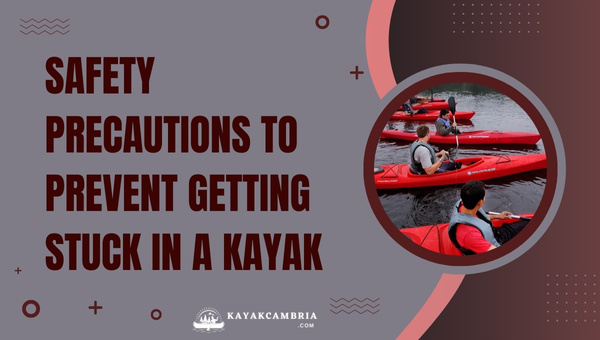
Practicing safety while kayaking is an essential aspect of ensuring a fun and enjoyable paddling experience. To minimize the risk of getting stuck in a kayak, it’s important to adopt the following safety precautions.
1. Always Wear A Personal Flotation Device (PFD)
A properly-fitting PFD, or life vest, should always be worn while kayaking. This vital piece of equipment provides precious extra time and buoyancy should you need to perform a wet exit or self-rescue. Make sure to select a PFD designed specifically for paddling, offering comfort and maximum freedom of movement.
2. Use A Spray Skirt
A spray skirt helps prevent water from entering the cockpit of a sit-inside kayak, reducing the chance of becoming stuck or waterlogged. Ensure that your spray skirt is a good fit for your kayak and that you understand how to release it quickly in the event of a capsize.
3. Regularly Check And Maintain Your Equipment
Before every kayaking trip, inspect your equipment to guarantee it’s in good working order. This includes checking for any damage or wear to your paddle, kayak hull, seat, and other essential components. Maintaining your gear can help prevent malfunctions or breakages while out on the water, which could potentially leave you stuck.
4. Paddle Within Your Skill Level
As tempting as it might be to attempt challenging conditions or rapids, it’s crucial to paddle within your skill level and gradually progress as you gain experience. Taking on a more difficult kayak excursion before you’re ready increases the risk of capsizing or getting lodged in tight spots.
5. Invest In A Safety Whistle And Marine Radio
Equip yourself with a loud safety whistle and a VHF marine radio. In the unlikely event of getting stuck in your kayak, these tools can help you communicate with other paddlers or signal for rescue in an emergency.
6. Take A Buddy Along
Whenever possible, it’s a good idea to paddle with a friend or in a group. Having experienced kayakers nearby provides additional support in case you require assistance, and it’s also a great way to learn new skills.
7. Learn Rescue Techniques
Familiarize yourself with various kayak self-rescue and assisted rescue techniques. With proper training and practice, you’ll be better prepared to address any situation where getting stuck in your kayak becomes a possibility.
Adhering to these safety precautions will not only reduce the risk of finding yourself stuck in a kayak but also contribute to a more enjoyable and fulfilling paddling experience overall.
What To Do If You Get Stuck In A Kayak in 2025?
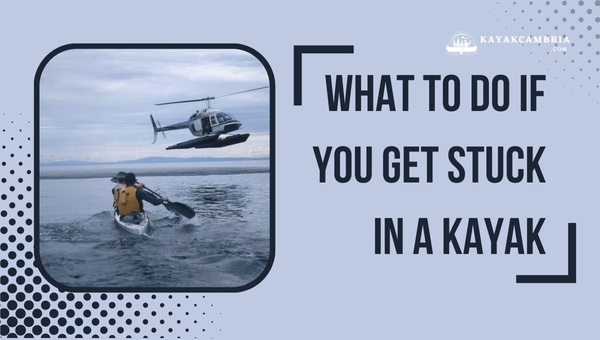
Being stuck in a kayak may be an unnerving experience, but it’s important to stay calm and focused. Here’s a step-by-step guide on what to do if you find yourself stuck in a kayak.
1. Assess The Situation And Stay Calm
First and foremost, take a deep breath and remind yourself that panicking will only make the situation worse. Assess your surroundings and evaluate the severity of your predicament. It’s essential to stay calm and composed in order to make rational decisions.
2. Perform A Wet Exit
If you’re in a sit-inside kayak and are capsized or stuck in any way, one crucial skill to know is the wet exit. While staying calm, move your hands to the sides of the cockpit, release your spray skirt (if any), and push yourself out. Keep in mind that your PFD (Personal Flotation Device) will help you stay buoyant.
3. Re-Enter Your Kayak
Now it’s time to get back into your kayak. Turn your kayak upright by gripping the cockpit’s far edge and flipping it back over. Once your kayak is right-side up, grab hold of the bow or stern and position it perpendicular to your body as you kick your legs to propel yourself up and onto the kayak. Finally, slide into your seat and secure your spray skirt.
4. Seek Assistance
If you’re unable to perform a wet exit and re-enter your kayak, it’s important to signal for help. Near or on the water, grab the attention of nearby paddlers by waving your arms or using a whistle. If you’re carrying a waterproof cell phone or marine radio, don’t hesitate to call for emergency assistance if needed.
Know Your Limits and Always Be Prepared
Getting stuck in a kayak can be a stressful experience, but by practicing the necessary skills, staying calm, and seeking assistance when needed, you can avoid further danger and safely resume your kayaking adventures. Remember: always paddle within your skill level, stay vigilant of your surroundings, and carry safety equipment to increase your chances of a successful and enjoyable trip on the water.
Kayaking With Confidence: Tips For Overcoming The Fear Of Getting Stuck
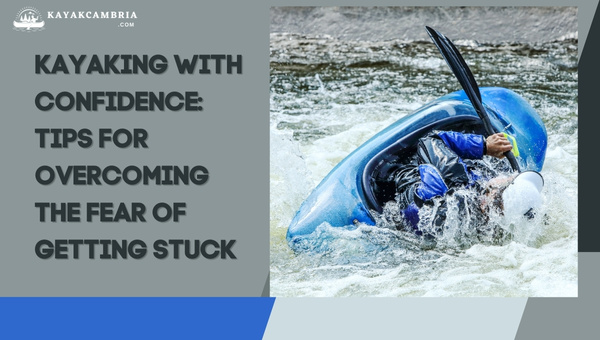
Taking up kayaking can be a thrilling and empowering experience, but for some people, the fear of getting stuck in a kayak can hold them back from fully enjoying the sport. Let’s explore some tips to help you overcome this fear and paddle confidently.
Understand The Unlikelihood Of Getting Stuck
First, it’s essential to recognize that instances of getting stuck in a kayak are relatively rare. Kayak designs have significantly evolved over the years, creating a relatively low risk of entrapment. Familiarize yourself with your kayak and the features designed for safety, like a spacious cockpit and sit-on-top models.
Equip Yourself With Knowledge And Skills
Enrolling in a kayaking class can be an excellent way to build your confidence. You’ll learn essential techniques such as the wet exit and kayak roll that can help you stay calm and collected in the case of a capsize. The more prepared you feel, the less likely your fear will hold you back.
Practice Makes Perfect
It can be helpful to practice those crucial safety techniques in calm waters regularly. As you become more comfortable with your skills, you’ll gain a sense of control that will reduce the fear of getting stuck.
Surround Yourself With Support
Joining a kayaking club or participating in group outings can be incredibly beneficial. In addition to having others around to offer encouragement and advice, you’ll also have the reassurance that help is nearby if you encounter any difficulties.
Test Different Kayaks
Trying out various kayak models and finding one that best suits your body size and personal preferences can make you feel safer and more comfortable on the water.
Develop A Safety Checklist
Compile a list of safety precautions to go through each time before you head out kayaking. This can help reinforce safe practices and make you feel more secure in your abilities. Be sure you have a fully equipped safety kit and are wearing appropriate attire and gear.
Commit To Mindfulness
Embrace the present moment and focus on the experience of kayaking. Practice deep, slow breathing to calm yourself down if you feel anxious or overwhelmed. Visualization techniques can help you mentally prepare for challenging situations, allowing you to react calmly if they should occur.
Recognize Your Progress
Acknowledge your achievements and how far you’ve come. Boosting your self-confidence will go a long way when faced with potentially difficult moments in kayaking.
By following these tips and trusting your abilities, you can overcome the fear of getting stuck in a kayak and paddle confidently through the water, enjoying the incredible outdoor adventure that kayaking offers.
Recognizing And Avoiding Hazards While Kayaking
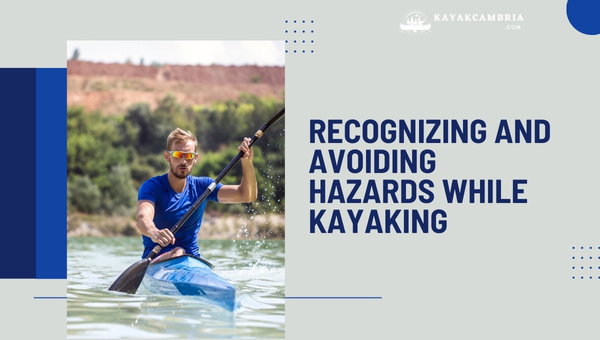
As a kayaking enthusiast, I cannot emphasize enough the importance of recognizing and avoiding hazards while out on the water. Paddling in a safe and responsible manner is crucial, not only for your own well-being but also for the preservation of the natural environment and the enjoyment of others around you. Here are some tips and strategies to keep in mind while kayaking to ensure an exciting and incident-free adventure.
Observe And Assess the Surroundings
First and foremost, develop a habit of continuously observing and assessing your surroundings as you paddle. This will allow you to identify potential hazards such as submerged objects, strong currents, overhanging branches, and other boaters or paddlers. By staying vigilant and maintaining situational awareness, you can better anticipate potential dangers and take appropriate action to avoid them.
Know The Weather Forecast And Water Conditions
Before you head out for your kayaking adventure, be sure to check the weather forecast as well as the latest water conditions for your intended paddling area. Sudden changes in weather can lead to unexpected hazards, such as strong winds, high waves, or even lightning. Additionally, swiftly rising water levels can bring an increase in debris and stronger currents which may pose a risk as you navigate your kayak.
Sail Within Your Skill Level
Another crucial aspect of avoiding hazards is paddling within your skill level. Understand your limitations and avoid overestimating your abilities. If you are a beginner, it may be best to stick to calm waters, such as lakes and slow-moving rivers, before venturing into more challenging environments such as ocean surf or whitewater rapids. Remember, practice makes perfect, and gaining experience in various conditions will help you develop confidence and expertise over time.
Follow Established Routes And Stick To The Shoreline
If you are unfamiliar with an area, it’s wise to follow established paddling routes or trails. Many popular kayaking locations offer route maps and signage that can help you navigate the waters safely. Additionally, sticking close to the shoreline can not only provide you with an easier exit point if needed but also allows you to avoid hazards like strong currents and boat traffic that are more common in open water.
Use Proper Paddling Techniques
Mastering proper paddling techniques can help you maintain stability, control, and maneuverability, ultimately reducing your risk of encountering hazards. Learn and practice basic strokes and techniques such as the forward stroke, sweep stroke, and draw stroke. Additionally, understand how to edge and control your kayak using hip movements and torso rotation.
Wear A Personal Flotation Device (PFD)
Finally, never underestimate the importance of wearing a personal flotation device (PFD) while kayaking. A well-fitting PFD can literally be a lifesaver in case of an unexpected capsizing or fall. In addition to providing buoyancy, PFDs also serve as a visible indicator of your presence in the water to other boaters.
Proper Paddling Techniques To Minimize The Risk Of Getting Stuck in 2025

As a seasoned kayaker, I can’t stress enough the importance of proper paddling techniques in minimizing the risk of getting stuck. By mastering these skills, you’ll maintain better balance and control of your kayak, ultimately making it easier to navigate tight spots or glide smoothly past any potential hazards. So, let’s dive into some of the essential techniques to enhance your paddling experience.
The Forward Stroke
- Plant the blade: Immerse one blade of the paddle into the water next to your toes, at a slight angle, ensuring it’s fully submerged.
- Rotate your torso: While keeping your arms fairly straight, engage the core and rotate your torso to propel the paddle through the water. This torso rotation should come from your hips and waist rather than just your arms, providing a more efficient and powerful stroke.
- Release and switch: When the blade reaches your hip, slice it out of the water by turning the paddle and repeat the process on the other side.
The Sweep Stroke
- Extend your arms: Hold the paddle with arms extended, one hand at the top of the paddle and the other positioned slightly below the shoulder.
- Wide-arc movement: Immerse the blade into the water near the toes and sweep it out in a wide arc, away from the kayak and towards the rear. Keep your outside arm straight and your inside arm slightly bent during the process.
- Efficient turning: To turn efficiently, utilize the sweep stroke on the opposite side of the intended turn direction.
The Reverse Stroke
- Reverse position: Hold the paddle in a similar position as in the forward stroke, with the blade next to your hips.
- Backward rotation: Rotate your torso while pushing the blade through the water toward your feet using your hips and core.
- Out and switch: At your toes, slice the blade out of the water, switch to the other side, and repeat.
The Draw Stroke
- Reach out: Extend one arm away from the kayak while holding the paddle parallel to the boat.
- Plant and pull: Place the paddle’s blade into the water, next to your hips, and pull it towards the kayak, using your torso and legs as leverage.
- Skimming motion: Once near the kayak, skim the blade out of the water and back to the starting position before repeating.
By incorporating these techniques into your kayaking repertoire, you can significantly reduce the chances of getting stuck.
Packing A Kayaking Safety Kit

Packing a well-equipped kayaking safety kit can make a significant difference in ensuring a successful and enjoyable paddling experience. Whether you’re a beginner or an experienced kayaker, having essential safety gear on hand can minimize your chances of getting stuck in a kayak and help you respond effectively in any emergency.
Kayaking Safety Essentials
Here are some basic items that should be included in your kayaking safety kit:
- Bilge Pump: A bilge pump is essential for removing water that may enter your kayak during a capsize. In such situations, the quicker you can empty your kayak, the faster you can get back on board and resume paddling.
- Paddle Float: A paddle float is a simple yet effective piece of gear that attaches to one end of your paddle, transforming it into an outrigger. It will help you stabilize your kayak and perform a self-rescue if needed.
- Towline: A towline is essential not only for towing a fellow kayaker but also for securing your kayak to shore or another vessel during a rescue. Ensure you have a durable, high-visibility towline that is at least 15 feet long.
Personal Safety Gears
In addition to the basic items listed above, you’ll want to incorporate some personal safety gear to carry on your person at all times:
- Whistle: Attach a loud, pea-less whistle to your PFD (personal flotation device) to signal for help in case of an emergency.
- Marine Radio: While a cell phone may suffice in some areas, a waterproof VHF marine radio will provide more reliable communication when paddling in remote locations or rough waters.
- Waterproof Pouch: To protect your cell phone and other valuables from water damage, invest in a waterproof, floatable pouch that can be tethered to your kayak.
Additional Safety Gear (Based on Anticipated Risks)
Depending on the nature of your kayaking adventures, it may be worth considering additional safety gear specific to your needs:
- Navigation Aids: Carry a waterproof map of the area and a compass in case technological devices fail. A GPS device can be a valuable addition but should be used as a backup, not a primary navigation tool.
- Flares and Strobe Lights: Pack visual signaling devices like flares, waterproof strobe lights, or LED flares to get help if you get lost or encounter an emergency on the water, especially during nighttime or with low visibility.
- First Aid Kit: Accidents can happen on the water, so it’s crucial to pack a comprehensive first aid kit including items like band-aids, gauze, tweezers, and pain relievers.
While the thought of getting stuck in your kayak may be daunting, having a well-prepared kayaking safety kit and the necessary knowledge will greatly reduce your chances of encountering such situations. Invest in quality safety gear, practice essential kayaking techniques, and paddle with confidence, knowing that you’ve taken the proper precautions.
Dressing Appropriately For Kayaking To Avoid Getting Stuck
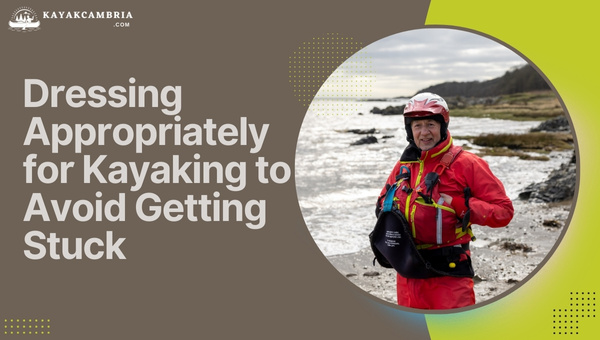
One aspect of kayaking that is often overlooked is the importance of dressing appropriately to minimize the risk of getting stuck in your kayak. Your choice of attire will directly impact your ability to enter, exit, and maneuver in your kayak with ease. With that in mind, let’s explore some best practices regarding clothing and footwear to keep you safe and agile while out on the water.
1. Choose Comfort And Mobility
First and foremost, select clothing that allows for a full range of motion. Avoid tight, restrictive garments, as they could hinder your ability to swiftly exit your kayak if needed. Opt for lightweight, moisture-wicking materials that keep you dry and comfortable. It is worth noting that cotton is a poor choice, as it retains water and can lead to chafing or hypothermia depending on the conditions.
2. Footwear Matters
When it comes to footwear, the best options are water shoes or sandals designed for aquatic activities. These provide necessary traction, protect your feet when entering or exiting the boat in rocky or slippery terrain, and drain water quickly. Ill-fitting or inappropriate footwear can make it harder to slip out of your kayak if you find yourself in a tight spot.
3. Cold-Water Paddling Clothing
If you’re venturing out in colder water, consider investing in a wetsuit or drysuit to maintain your body temperature and help mitigate the risk of hypothermia. These specialized garments allow a more comfortable kayaking experience and reduce the risk of getting stuck, as your body remains more flexible and agile when properly insulated.
4. Layering Is Key
Using layers can be an effective strategy for proper kayak attire. This approach helps you to adapt to changing weather conditions and personal comfort throughout your adventure. A base layer of moisture-wicking fabric close to your skin helps with temperature regulation, while insulating layers on top, such as fleece or synthetic materials, provide added warmth. Additionally, an outer shell layer acts as a barrier against wind and water.
5. Assess And Adapt
Before each paddle, take the time to assess your clothing and make sure it offers the mobility and functionality needed for your trip. Pay attention to any areas where the fabric may bunch or restrict movement, as these could become problematic if you need to exit your kayak quickly. The key to avoiding getting stuck in a kayak often lies in the way you dress, so be sure to make thoughtful decisions to ensure a safe and enjoyable experience.
Mental Preparation And Mindset For Successful Kayaking in 2025

An often overlooked but essential aspect of kayaking is mental preparation and mindset. This is critical not only for preventing a situation where you could get stuck in a kayak but also for ensuring a successful and enjoyable paddling experience. By having the right mindset, you can approach kayaking with confidence even when facing challenges. Let’s explore some ways to cultivate a positive and prepared attitude.
Embrace The Learning Process
As with any new skill, learning to kayak can take time and patience. Understand that you may not be a pro from the outset, and that’s perfectly normal. Keep an open mind and embrace the learning process. Give yourself the time and space to develop your skills, and celebrate your progress incrementally.
Practice Visualization Techniques
One way to improve your ability to handle challenging situations while kayaking is to practice visualization techniques. Before you embark on a trip, spend some quiet time mentally picturing yourself navigating through obstacles, executing the perfect stroke, or recovering from a capsize. By doing so, you’ll help train your brain to respond more calmly and effectively when faced with real-life scenarios.
Cultivate A Positive Attitude
Having a positive attitude is crucial for overcoming any hurdles and achieving success in kayaking. Avoid negative self-talk or getting discouraged by occasional setbacks. Instead, focus on your accomplishments – no matter how small – and be proud of yourself for continuously pushing your boundaries and improving. Surrounding yourself with like-minded, supportive paddlers is also a great way to maintain a positive mindset.
Prioritize Fun And Adventure
Remember that kayaking is meant to be a fun, exhilarating, and adventurous activity. It’s essential to keep this in mind even when facing challenging situations. By making fun a priority, you’ll be more likely to stay calm and composed when things get tough, making it less likely that you’ll get stuck in your kayak or encounter troubles.
Develop A Healthy Respect For The Water
Being mentally prepared also means having a healthy respect for the water and understanding that nature can be unpredictable. This mindset helps you stay humble, adaptable, and prepared for the unexpected, minimizing the risk of getting stuck or encountering other issues.
Mental preparation and mindset are critical factors in maximizing your kayaking experience and preventing sticky situations. By learning to foster a positive attitude, embrace the learning process, and stay adaptable on the water, you’re setting yourself up for a successful and enjoyable time on the water.
Frequently Asked Questions
1. Am I more likely to get stuck in a sit-inside or sit-on-top kayak?
Sit-inside kayaks tend to have a narrower cockpit, which could make it slightly more challenging to exit in an emergency. However, if properly fitted and equipped with a spray skirt, the risk of getting stuck is minimal. Sit-on-top kayaks, on the other hand, offer an open design that allows for easy entry and exit. You’re less likely to get stuck, but it’s essential to choose the right kayak for your body type and skill level.
2. Can my choice of clothing make it difficult for me to get out of a kayak if needed?
Yes, inappropriate clothing could potentially make it difficult to exit a kayak in an emergency. Opt for clothes that provide comfort and mobility, and ensure your footwear won’t get caught on footrests or other kayak parts. In cold-water conditions, consider using specialized clothing such as wetsuits or drysuits to avoid hypothermia while maintaining ease of movement.
3. Is it important for me to learn rescue techniques even if I only kayak in calm water?
Absolutely. While paddling in calm water might lessen the chance of your kayak capsizing, it’s crucial to be prepared for any situation. You should learn basic rescue techniques like the wet exit and kayak roll to ensure you can safely exit your kayak if it capsizes. Additionally, practicing these skills will boost your overall confidence and abilities as a kayaker.
4. What should I have in my kayaking safety kit to prevent or manage getting stuck?
Your kayaking safety kit should contain essential items to assist you in an emergency. At a minimum, include a bilge pump, paddle float, and towline. Personal items such as a whistle, marine radio, and a waterproof, fully charged cell phone can also be lifesavers. Evaluate your specific kayaking excursions and potential risks to determine if additional safety gear is necessary.
5. How can I practice exiting a kayak without actually getting stuck?
Practice exiting and re-entering your kayak in a controlled environment like a swimming pool or calm and shallow water with a buddy to ensure safety. This will help you build muscle memory and confidence in your ability to exit the kayak swiftly. For sit-inside kayaks, practice the ‘hug to the front and slide out’ technique, focusing on keeping calm and moving smoothly. For sit-on-top kayaks, work on perfecting a side-saddle exit and re-entry. Engaging in these practice exercises will ultimately reduce the likelihood of getting stuck in a kayak when faced with a real-life scenario.
Conclusion
Although the possibility of getting stuck in a kayak may seem intimidating, it’s important to remember that with proper preparation and knowledge, it can be largely preventable. By choosing the right kayak, mastering essential skills such as the wet exit and kayak roll, and taking necessary safety precautions, you can enjoy this wonderful outdoor activity with confidence. Additionally, remember to stay aware of potential hazards in the water, learn effective paddling techniques, and pack a kayaking safety kit for added security.
Furthermore, it’s crucial to dress appropriately for kayaking and ensure that your clothing allows for easy mobility in case of an emergency. Lastly, maintaining a positive mindset, learning from your experiences, and embracing the challenges involved in kayaking can help you overcome any fears about getting stuck.
Remember that kayaking is meant to be a fun and enjoyable adventure, and by staying informed and prepared, you can reduce the risks and focus on the countless moments of joy, serenity, and awe that await you on the water. So go ahead, grab your paddle, and let the spirit of adventure be your guide!

